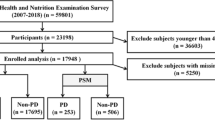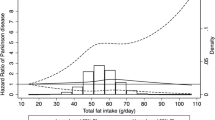Abstract
Background
There has been emerging attention to investigate the possible role of some dietary factors in the pathogenesis of Parkinson’s disease (PD); however, evidence about the relationship between dietary components and the risk of PD is limited. The aim of this study was to determine the association between major dietary patterns and the risk of PD.
Methods
This case–control study was performed on 105 patients with newly diagnosed PD and 215 healthy controls. Diagnosis of Parkinson’s disease was made based on the UK Brain Bank criteria. Usual dietary intakes were collected by a validated semi-quantitative food frequency questionnaire. Dietary patterns were detected by principal component analysis.
Results
Four dietary patterns, including traditional, healthy, western, and light dietary patterns, were identified. After considering all potential confounders, individuals with the highest tertile of traditional dietary pattern scores had a lower risk of PD than those with the lowest tertile (OR: 0.002; 95% CI: 0.000–0.016). A similar inverse association between the healthy pattern (OR: 0.314; 95% CI: 0.131–0.750) and light pattern (OR: 0.282; 95% CI: 0.121–0.654) and risk of PD was revealed. In contrast, adherence to the western dietary pattern was associated with PD incidence (OR: 7.26; 95% CI: 2.76–19.09).
Conclusions
The findings of this study suggest that adherence to western dietary pattern could increase the risk of PD by approximately seven times. However, the traditional, healthy, and light dietary patterns had an inverse relationship with PD risk.
Similar content being viewed by others
Data availability
Data are available if it is necessary.
Availability of data and materials
Not applicable.
References
Poewe W, Mahlknecht P (2009) The clinical progression of Parkinson’s disease. Parkinsonism Relat Disord 15:S28–S32
Grimes D, Fitzpatrick M, Gordon J, Miyasaki J, Fon EA, Schlossmacher M et al (2019) Canadian guideline for Parkinson disease. CMAJ 191(36):E989–E1004
Lee TK, Yankee EL (2021) A review on Parkinson’s disease treatment. Neuroimmunol Neuroinflamm 8:222
Ciulla M, Marinelli L, Cacciatore I, Stefano AD (2019) Role of dietary supplements in the management of Parkinson’s disease. Biomolecules 9(7):271
Armstrong MJ, Okun MS (2020) Diagnosis and treatment of Parkinson disease: a review. JAMA 323(6):548–560
Wang A, Lin Y, Wu Y, Zhang D (2015) Macronutrients intake and risk of Parkinson’s disease: a meta-analysis. Geriatr Gerontol Int 15(5):606–616
Seidl SE, Santiago JA, Bilyk H, Potashkin JA (2014) The emerging role of nutrition in Parkinson’s disease. Front Aging Neurosci 6:36
Hantikainen E, Roos E, Bellocco R, D’Antonio A, Grotta A, Adami H-O et al (2022) Dietary fat intake and risk of Parkinson disease: results from the Swedish National March Cohort. Eur J Epidemiol 37(6):603–613
Ascherio A, Schwarzschild MA (2016) The epidemiology of Parkinson’s disease: risk factors and prevention. Lancet Neurol 15(12):1257–1272
Liu Y-H, Jensen G, Na M, Mitchell D, Wood GC, Still C et al (2020) Diet quality and risk of Parkinson disease: a prospective study and a meta-analysis. Curr Dev Nutr 4(Supplement_2):1442-
Bianchi VE, Rizzi L, Somaa F (2023) The role of nutrition on Parkinson’s disease: a systematic review. Nutr Neurosci 26(7):605–628
Dong J, Beard JD, Umbach DM, Park Y, Huang X, Blair A et al (2014) Dietary fat intake and risk for Parkinson’s disease. Mov Disord 29(13):1623–1630
Okubo H, Miyake Y, Sasaki S, Murakami K, Tanaka K, Fukushima W et al (2012) Dietary patterns and risk of Parkinson’s disease: a case–control study in Japan. Eur J Neurol 19(5):681–688
Knight E, Geetha T, Burnett D, Babu JR (2022) The role of diet and dietary patterns in Parkinson’s disease. Nutrients 14(21):4472
Hughes AJ, Daniel SE, Kilford L, Lees AJ (1992) Accuracy of clinical diagnosis of idiopathic Parkinson’s disease: a clinico-pathological study of 100 cases. J Neurol Neurosurg Psychiatry 55(3):181–184
Hu FB, Rimm E, Smith-Warner SA, Feskanich D, Stampfer MJ, Ascherio A et al (1999) Reproducibility and validity of dietary patterns assessed with a food-frequency questionnaire. Am J Clin Nutr 69(2):243–249
Asghari G, Rezazadeh A, Hosseini-Esfahani F, Mehrabi Y, Mirmiran P, Azizi F (2012) Reliability, comparative validity and stability of dietary patterns derived from an FFQ in the Tehran Lipid and Glucose Study. Br J Nutr 108(6):1109–1117
Esmaillzadeh A, Azadbakht L (2008) Major dietary patterns in relation to general obesity and central adiposity among Iranian women. J Nutr 138(2):358–363
Cheng H (2016) A simple, easy-to-use spreadsheet for automatic scoring of the International Physical Activity Questionnaire (IPAQ) Short Form (updated November 2016). ResearchGate, editor
Chumlea WC, Roche AF, Steinbaugh ML (1985) Estimating stature from knee height for persons 60 to 90 years of age. J Am Geriatr Soc 33(2):116–120
Roohafza H, Feizi A, Gharipour M, Khani A, Dianatkhah M, Sarrafzadegan N et al (2021) Development and validation of a socioeconomic status short-form questionnaire (SES-SQ). ARYA Atheroscler 17(4):1–9
Sabour H, Soltani Z, Latifi S, Javidan AN (2016) Dietary pattern as identified by factorial analysis and its association with lipid profile and fasting plasma glucose among Iranian individuals with spinal cord injury. J Spinal Cord Med 39(4):433–442
Mischley LK, Lau RC, Bennett RD (2017) Role of diet and nutritional supplements in Parkinson’s disease progression. Oxid Med Cell Longev. 2017:6405278-
Gao X, Chen H, Fung TT, Logroscino G, Schwarzschild MA, Hu FB et al (2007) Prospective study of dietary pattern and risk of Parkinson disease. Am J Clin Nutr 86(5):1486–1494
Georgiou A, Demetriou CA, Christou YP, Heraclides A, Leonidou E, Loukaides P et al (2019) Genetic and environmental factors contributing to Parkinson’s disease: a case-control study in the Cypriot population. Front Neurol 1047
Pandey P, Raizada R, Srivastava L (2010) Level of organochlorine pesticide residues in dry fruit nuts. J Environ Biol 31(5):705–707
Ruiz-Ojeda FJ, Plaza-Díaz J, Sáez-Lara MJ, Gil A (2019) Effects of sweeteners on the gut microbiota: a review of experimental studies and clinical trials. Adv Nutr 10(suppl_1):S31–S48
Davis J, Grandinetti A, Waslien C, Ross G, White L, Morens D (1996) Observations on serum uric acid levels and the risk of idiopathic Parkinson’s disease. Am J Epidemiol 144(5):480–484
de Lau LM, Koudstaal PJ, Hofman A, Breteler MM (2005) Serum uric acid levels and the risk of Parkinson disease. Ann Neurol 58(5):797–800
Aihemaitijiang S, Zhang Y, Zhang L, Yang J, Ye C, Halimulati M et al (2020) The association between purine-rich food intake and hyperuricemia: a cross-sectional study in Chinese adult residents. Nutrients 12(12):3835
Choi HK, Liu S, Curhan G (2005) Intake of purine-rich foods, protein, and dairy products and relationship to serum levels of uric acid: the Third National Health and Nutrition Examination Survey. Arthritis Rheum 52(1):283–289
Andreadou E, Nikolaou C, Gournaras F, Rentzos M, Boufidou F, Tsoutsou A et al (2009) Serum uric acid levels in patients with Parkinson’s disease: their relationship to treatment and disease duration. Clin Neurol Neurosurg 111(9):724–728
Songsomboon C, Tanprawate S, Soontornpun A, Wantaneeyawong C, Louthrenoo W (2020) Serum uric acid, serum uric acid to serum creatinine ratio and serum bilirubin in patients with Parkinson’s disease: a case-control study. J Clin Med Res 12(3):172
Tan AH, Chong CW, Lim SY, Yap IKS, Teh CSJ, Loke MF et al (2021) Gut microbial ecosystem in Parkinson disease: new clinicobiological insights from multi-omics. Ann Neurol 89(3):546–559
Heinzel S, Aho VT, Suenkel U, von Thaler AK, Schulte C, Deuschle C et al (2020) Retracted: gut microbiome signatures of risk and prodromal markers of Parkinson disease. Ann Neurol 88(2):320–331
Chen S-J, Chen C-C, Liao H-Y, Lin Y-T, Wu Y-W, Liou J-M et al (2022) Association of fecal and plasma levels of short-chain fatty acids with gut microbiota and clinical severity in patients with Parkinson disease. Neurology 98(8):e848–e858
Chen Y, Chang SKC, Zhang Y, Hsu C-Y, Nannapaneni R (2020) Gut microbiota and short chain fatty acid composition as affected by legume type and processing methods as assessed by simulated in vitro digestion assays. Food Chem 312:126040
Davis C, Bryan J, Hodgson J, Murphy K (2015) Definition of the Mediterranean diet: a literature review. Nutrients 7(11):9139–9153
Solch RJ, Aigbogun JO, Voyiadjis AG, Talkington GM, Darensbourg RM, O’Connell S et al (2022) Mediterranean diet adherence, gut microbiota, and Alzheimer’s or Parkinson’s disease risk: a systematic review. J Neurol Sci 434:120166
Yin W, Löf M, Pedersen NL, Sandin S, Fang F (2021) Mediterranean dietary pattern at middle age and risk of Parkinson’s disease: a Swedish cohort study. Mov Disord 36(1):255–260
Alcalay RN, Gu Y, Mejia-Santana H, Cote L, Marder KS, Scarmeas N (2012) The association between Mediterranean diet adherence and Parkinson’s disease. Mov Disord 27(6):771–774
Saul C, Mata I, Peres K (2021) The benefits of extra virgin olive oil polyphenols for possible prevention of Parkinson’s disease: an integrative mini literature review. Int Phys Med Rehab J 6(3):54–56
Shah SP, Duda JE (2015) Dietary modifications in Parkinson’s disease: a neuroprotective intervention? Med Hypotheses 85(6):1002–1005
Schisterman EF, Cole SR, Platt RW (2009) Overadjustment bias and unnecessary adjustment in epidemiologic studies. Epidemiology 20(4):488–495
Acknowledgements
This study was extracted from an MSc dissertation, which was approved by the School of Nutrition & Food Science, Isfahan University of Medical Sciences (code: IR.MUI. RESEARCH. REC. 1398.774). The authors would like to offer their gratitude to all the study participants.
Funding
This study was supported by the Isfahan University of Medical Science. The funders had no role in the study design, data collection, analysis, decision to publish, or preparation of the manuscript.
Author information
Authors and Affiliations
Contributions
N.S. and A.B. designed the study. R.G. and A.B. performed abstract screening and data extraction. A.F. analyzed the data. N.S., A.B., and R.G. drafted the manuscript.
Corresponding author
Ethics declarations
Ethics approval and consent to participate
This study protocol was approved by the ethics committee of Isfahan University of Medical Sciences (IR.MUI. RESEARCH. REC. 1398.774).
Conflict of interest
The authors declare no competing interests.
Additional information
Publisher's Note
Springer Nature remains neutral with regard to jurisdictional claims in published maps and institutional affiliations.
Supplementary Information
Below is the link to the electronic supplementary material.
Rights and permissions
Springer Nature or its licensor (e.g. a society or other partner) holds exclusive rights to this article under a publishing agreement with the author(s) or other rightsholder(s); author self-archiving of the accepted manuscript version of this article is solely governed by the terms of such publishing agreement and applicable law.
About this article
Cite this article
Shokri-Mashhadi, N., Ghiasvand, R., Feizi, A. et al. Association between major dietary patterns and Parkinson’s disease risk: a case–control study. Neurol Sci 45, 2003–2010 (2024). https://doi.org/10.1007/s10072-023-07204-x
Received:
Accepted:
Published:
Issue Date:
DOI: https://doi.org/10.1007/s10072-023-07204-x




